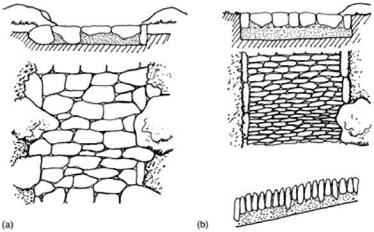This is the best, most hard-wearing material, which blends into many landscapes. In the most rugged and mountainous terrain, steps can be very irregular in size and shape, so that they
 |
Stone paving: (a) A section and plan of paving using natural stone. A level surface is achieved by laying the irregular stones at various depths. The path is tied into the terrain by using occasional larger rocks along the edges. (b) Narrow stones set on edge provide a surface with plenty of grip on steeper slopes. This traditional method was used in mountainous areas such as the Alps to give grip to sheep or cattle during migrations to mountain pastures.
|
|
Step layout: (a) Avoid long runs of steps on a
straight slope. These are daunting and tiring to climb. (b) Select a route where the steps can be divided into shorter sections with ramps and landings in between.
bottom and rear can be rougher, being dug into the foundations or packed level with smaller stones. Round stones are not suitable. Naturally bedded hard rocks, or those that split cleanly, are usually the best to use. Softer rocks may erode beneath heavy foot traffic.
The edges of the steps may need to be retained to prevent sideways movement. Larger stones can be used for this on the down-slope side, and can act as safety barriers or handholds in precipitous terrain. Such stone steps should be checked and repaired regularly, as sudden movement or disintegration of steps can cause ankle injuries. Stone steps can also be cut from the rock itself using a pneumatic drill (jackhammer) or similar tool.




